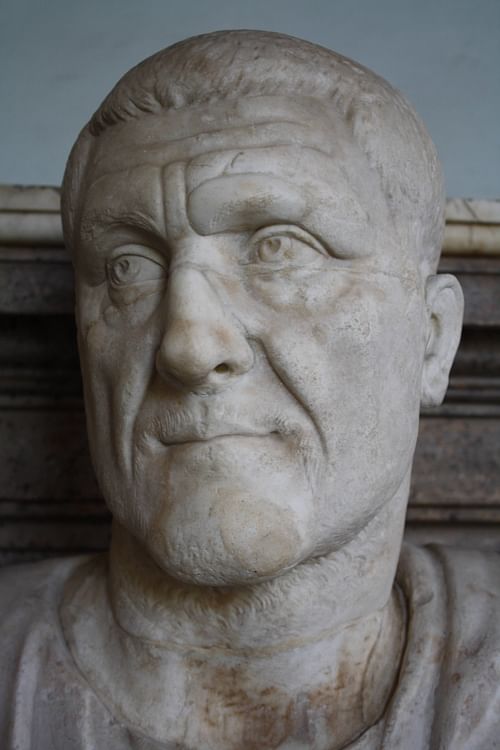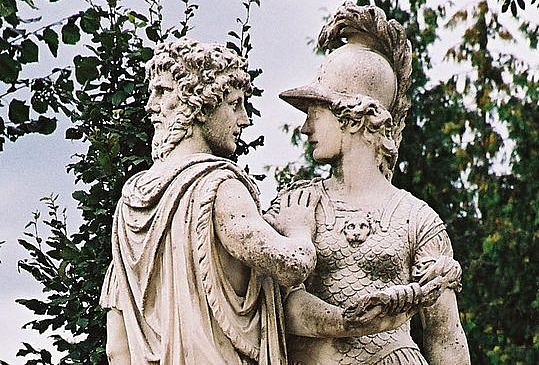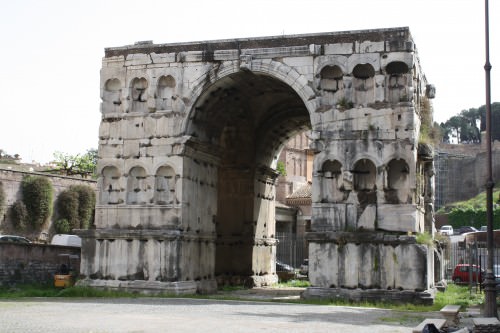Maximinus Thrax › Janus » Ancient origins
Articles and Definitions › Contents
- Maximinus Thrax › Antique Origins
- Janus › Who Was
Ancient civilizations › Historical and archaeological sites
Maximinus Thrax › Antique Origins
Definition and Origins

Maximinius Thrax ruled briefly as the Roman emperor from 235 CE to his death in 238 CE. The young Roman Emperor Alexander Severus secured the imperial throne after the assassination of his cousin Elagabalus by the Praetorian Guard in 222 CE. Thirteen years later in 235 CE, after unsuccessful assaults against the Parthians and Germans, the army, tired of his inability to command, murdered him and his mother, Julia Mamaea, and rallied behind a semi-illiterate barbarian commander named Maximinus Thrax. Unfortunately, his lack of support in the Roman Senate and several costly military expeditions would spell his own demise three years later.
Gaius Julius Verus was born in 172 or 173 CE in Thrace, a region northeast of Macedonia near the Black Sea, to a peasant father and an Alanic mother. Because of his place of birth, he became identified with the name of Thrax. In 190 CE he entered the military and because of his immense size and strength, quickly rose through the ranks, eventually commanding a legion in Egypt in 232 CE, governing the Roman province of Mesopotamia, and lastly, in 234 CE leading recruits in Germany. At a very opportune moment, Maximinus would be acclaimed as the empire ’s new leader.
In the early spring of 235 CE Alexander Severus and his mother attempted an offensive against the Germans with the sole intent of resurrecting the young emperor's image with the army and people of Rome. Unfortunately, he chose to negotiate instead of fight. The army was furious and rallied behind Maximinus against Alexander. After the assassination of the emperor and his mother - their bodies were returned to Rome - Maximinus was proclaimed emperor near the present-day city of Mainz on March 20, 235 CE. The Roman Senate reluctantly approved, even though they considered him a barbarian and below their social standing. His son Gaius Julius Verus Maximus would be named Caesar. Historian Herodian in his History of the Roman Empire wrote of the new emperor,
His character was naturally barbaric, as his race was barbarian. He had inherited the brutal disposition of his countrymen, and he intended to make his imperial position secure by acts of cruelty, fearing that he would become an object of contempt to the Senate and the people, who might be more conscious of his lowly origin than impressed by the honor he had won.
After assuming the imperial title, the new emperor recognized his lack of the necessary support in the Senate and remained cautious. Those in Rome, as well as many in the army, preferred a senator named Magnus; however, when news of the plot became known, several of his followers met their untimely death on the orders of Maximinus. Others, who remained loyal to Alexander, chose Titus Quartinus as emperor, but unfortunately he met his death as he slept at the hands of one of his most vocal supporters, a man named Macedo who elected to change sides and support Maximinus instead. Herodian noted,
Although he had no reason for enmity or hatred, Macedo killed the man whom he himself had chosen and persuaded to accept the empire. Thinking that this act would win him great favor with Maximinus, Macedo cut off Quartinus' head and brought it to the emperor. When he learned of the deed, Maximinus, though he believed that he had been freed from a dangerous enemy, nevertheless had Macedo killed, when the man had every reason to hope and believe that he would receive a generous reward.
BUILDING A PONTOON BRIDGE AND CROSSING THE RHINE, THE NEW EMPEROR MOVED FURTHER INTO GERMANY, PLUNDERING AND BURNING VILLAGES AS HE WENT.
Building a pontoon bridge and crossing the Rhine, the new emperor moved further into Germany, plundering and burning villages as he went. After a fierce battle near Wurttemberg and Baden and despite heavy losses, he was proclaimed Germanicus Maximus. Peace in the region was restored. From 235-236 CE he advanced towards the Danube, earning the titles of Dacius Maximus and Samaticus Maximus. However, his problems lay not in Germany but back in Rome - a city he would actually never see. His push into Germany had drained the finances of the empire, and his cuts in subsidies on the city's grain supply harmed his reputation with the people, especially the poor. Herodian remarked,
After Maximinus had impoverished most of the distinguished men and confiscated their estates, which he considered small and insignificant and not sufficient for his purposes, he turned to the public treasuries; all the funds which had been collected for the citizens' welfare or for gifts, all the funds being held in reserve for shows or festivals, he transferred to his own personal fortune.
Realizing they could no longer tolerate the excesses of Maximinus, the Senate threw their support behind the eighty-year-old governor of Africa, Marcus Antonius Gordianus Sempronianus or Gordian I. Maximinus was declared an enemy of the state.
Gordianus and his son Gordian II, who was proclaimed Augustus by his father, may have had the support of the Senate but their days on the throne were numbered. Capellianus, governor of Numidia and an ally of Maximinus, advanced his legions toCarthage and after defeating the small militia killed the forty-six-year-old Gordian II. His father, hearing of his son's assassination, hanged himself. They had been in power for only twenty-two days. Still refusing to accept Maximinus as emperor, the Senate appointed co-emperors - Decius Caelius Calvinus Balbinus and Marcus Clodius Pupienus Maximus.They also named a Council of Twenty to advise them. Regrettably, the new emperors were not welcomed warmly by the people of Rome, indeed the two received a hail of stones are they walked through the streets and the citizens preferred the thirteen-year-old nephew of Gordian II, Marcus Antonius Gordianus. To appease the citizenry, the boy who would become Gordian III was named Caesar.
After hearing of the Gordian appointment and despite the growing animosity of his troops, Maximinus moved his army towards Italy. He reached the city of Emosa but found it to be evacuated. He travelled further to the walled city of Aquileia, but his repeated attacks on the city failed. Emperor Pupienus set out from Rome to meet Maximinus. The losses at Aquileia, combined with the shortage of food, were too much for the Praetorian Guard and in May of 238 CE they murdered both the emperor and his son with their heads being escorted back to Rome. Pupienus entered Aquileia a hero. Herodian, who refers to the victorious co-emperor as Maximus, wrote that the city opened their gates and welcomed Maximus into the city. According to Herodian, many of the defeated men of Maximinus remained angry, grieving their fallen commander,
The men cheered Maximus and scattered leaves in his path. The soldiers who were besieging Aquileia came forward carrying laurel branches symbolic of peaceful intent, not because this represented their true feelings but because the presence of the emperor forced them to pretend respect and good will.
The death of Maximinus brought about what many historians consider a period of crisis and chaos. Pupienus returned to Rome a hero but soon quarreled with the jealous Balbinus. Tired of both men the Praetorian Guard stormed the imperial palace. seized the emperors, and dragged their bodies through the streets of Rome. Gordian III was proclaimed the new emperor, the last in the Year of the Six Emperors.
Janus › Who Was
Definition and Origins

The Roman Republic owed much to the cultural influence of its Greek neighbors. For centuries the Greeks occupied a prominent position to the south on the island of Sicily. A series of wars in the 2nd and 3rd centuries BCE brought to the city a tremendous Hellenic presence: art, literature, philosophy, and most significantly, religion. Although a rich religious tradition had existed long before the arrival of the Greeks, the pantheon of Greek gods quickly merged with those already present. However, there was one god with no Greek counterpart -- one who symbolized both beginning and end. His name was evoked even before that of Jupiter. His name was Janus.
Despite the influence of these newly arrived gods, there was one significant difference between Greek and Roman worship: the importance of rituals. To the Romans rituals were extremely important. They were a veiled attempt to avoid the dangers of religious zeal. If a ritual were performed properly, an individual would be rewarded; if not, he could be punished. This reliance would continue long after the arrival of the Greek pantheon.
TO ALL ROMANS JANUS WAS THE GOD OF BEGINNINGS & ENDS, PRESIDING OVER EVERY ENTRANCE & DEPARTURE.
ROMAN RITUALS & GODS
Initially, even before the Capitoline triad, Roman religion was based on the cult of the household -- a belief that spirits or numina inhabited everything around them, people included. There was an array of domestic deities: Vesta, the spirit of the hearth (later to be associated with the Vestal Virgins); Penates, the guardians of the pantry (later protectors of the Roman state); Lar Familiaris, the spirit of the cultivated land (also the guardian of the family fortune); and lastly, Janus, the spirit of the doorway or ianua. Although usually benign, these spirits could be angered, especially if ignored. Every home contained a small cupboard containing their images and a small portion of each meal honored them. Eventually, many of these household spirits became state deities.
JANUS' LEGEND & ATTRIBUTES
Janus was one of the earliest of the Roman deities, sometimes referred to as the “god of gods” or diuom deo; others equated him with the Etruscan god Culcans. However, there are at least two notable myths concerning his origin. And, according to both, unlike other Roman and Greek gods, Janus may have actually lived. In the first myth, he ruled alongside an early Roman king named Camesus. After Janus' exile from Thessaly (a province in northern Greece ), he arrived in Rome with his wife Camise or Camasnea and children, the most notable being Tiberinus (god of the Tiber). Shortly after arriving, he built a city on the west bank of the Tiber named Janiculum. Following the death of Camesus, he ruled Latium peacefully for many years. He supposedly received Saturn when the god was driven from Greece. Upon his own death, Janus was deified. The second myth has him present at the time of Romulus, the founder of Rome. Following Romulus's kidnapping of the Sabine women, Rome was attacked. As the enemy, under the leadership of Titus Tatius, scaled the walls of the city, Janus launched a powerful jet spray of hot water, forcing them to retreat. To celebrate this deed the doors of the Temple of Janus at the Forum are always left open so he can assist the Roman soldiers in time of war. Allegedly, Romulus established a cult honoring Janus.

Janus
According to some, he was the custodian of the universe but, to all Romans, he was the god of the beginnings and the ends, presiding over every entrance and departure, and because every door and passageway looks in two directions, Janus was seen as two-faced or Janus bifrons -- the god who looked both ways. He was the gatekeeper; his symbols were a porter's staff or virga and a set of keys. To illustrate his importance, his name was even mentioned before Jupiter in prayers. He protected the start of all activities. He inaugurated the seasons. The first day of each month was considered sacred to him but the first month of the year -- January -- which many in the present day consider named in his honor -- was actually named for Juno, queen of the gods. Early Romans coins featured his image, showing him as two-faced, one bearded and one clean-shaven.Later, during the Renaissance, this image of two faces would represent not only the past and future but also wisdom.
CLOSING THE DOORS TO JANUS' SHRINES
There were five shrines built to honor Janus Geminus in Rome, all of which were located near crossings of rivers or watercourses, owing to his early connections to water and bridges. The most important of these shrines was near the Argiletum entrance to the Forum. This particular shrine had bronze doors on the east and west sides, and according to tradition, the doors were kept closed in times of peace and open in times of war. However, since the Romans seemed to always to be at war somewhere, the doors were almost never closed. Also important was the manner in which the army left to wage war; they had to exit the city according to ritual in order to be protected by Janus. Failure to do so could result in defeat.

Arch of Janus
In January of 48 BCE, during the time of Julius Caesar, the Roman Senate authorized a ceremony ( augurium salutis ) when the temple doors were finally closed -- a symbol that Caesar ’s victories had finally brought peace to the Republic. This would not be the last time an emperor would close the doors. Early in his reign, Emperor Augustus opted to continue many of the old religious traditions and rituals in an attempt to reinvigorate the worship of the old gods and get away from cults and foreign gods. He rebuilt many of the old shrines and temples that had fallen into disrepair. Because of this, during Rome's war in Spain in 26 BCE, the army continued the practice of exiting correctly through the doors of Janus' shrine. These doors were ceremoniously closed upon their successful return seven years later.
The Greeks had a tremendous influence on Rome: its culture, its self-image and, of course, religion. However, one often forgets that there was religion in Rome prior to this contact. There was, however, a dramatic shift. Roman gods became more Greek, that is, more human-like with all of the foibles of humankind: love, hate, jealousy, etc. However, there was one god who never changed; he was the beginning and the end. He had no Greek counterpart. He was uniquely Roman. He was Janus.
LICENSE:
Article based on information obtained from these sources:with permission from the Website Ancient History Encyclopedia
Content is available under License Creative Commons: Attribution-NonCommercial-ShareAlike 3.0 Unported. CC-BY-NC-SA License